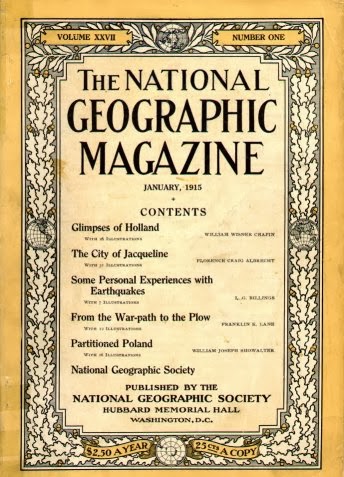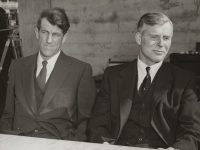
Cover of January 1915 National Geographic
On January 27, 1888, the National Geographic Society, one of the largest non-profit scientific and educational institutions in the world, is founded in the Cosmos Club, a private club then located on Lafayette Square in Washington, D.C. You might not be aware of it, but several of our past articles already are related to the National Geographic Society, as the society always has supported and funded research projects as well as prominent exploration projects.
A Club for an Elite Group of Academics…
Actually, the National Geographic Society began as a club for an elite group of academics and wealthy patrons interested in travel. On January 13, 1888, 33 explorers and scientists gathered at the Cosmos Club, a private club then located on Lafayette Square in Washington, D.C., to organize “a society for the increase and diffusion of geographical knowledge.” After preparing a constitution and a plan of organization, the National Geographic Society was incorporated two weeks later. Gardiner Greene Hubbard became its first president and his son-in-law, Alexander Graham Bell, eventually succeeded him in 1897 following his death. In 1899 Bell’s son-in-law Gilbert Hovey Grosvenor was named the first full-time editor of National Geographic Magazine and served the organization for fifty-five years (1954), and members of the Grosvenor family have played important roles in the organization since.
Photographs to tell Stories
Bell and his son-in-law, Grosvenor, devised the successful marketing notion of Society membership and the first major use of photographs to tell stories in magazines. The National Geographic Magazine, later shortened to National Geographic, published its first issue in October 1888, nine months after the Society was founded as the Society’s official journal, a benefit for joining the tax exempt National Geographic Society. While the first issue was distributed to 200 charter members only, by today, the magazine reaches around 60 million readers worldwide each month. The National Geographic Magazine is famous for its photographies. This started already in January 1905, when Grosvenor filled 11 pages of the magazine with photos of Lhasa in Tibet. Expecting to be fired, he was instead congratulated by Society members.
National Geographic Society Today
Today, the National Geographic Society claims that it is its mission to inspire people to care about the planet. Throughout its history, it has encouraged conservation of natural resources and raised public awareness of the importance of natural places, the plants and wildlife that inhabit them and the environmental problems that threaten them. It is one of the world’s largest nonprofit scientific and educational organizations, has funded more than 10,000 scientific research, conservation and exploration projects around the globe.
Expeditions
The very first expedition sponsored by the National Geographic Society in 1890 mapped the Mount St. Elias region in Alaska and discovered Mount Logan, Canada’s highest peak. Past and current grantees include polar explorer Robert Peary, who was the first to reach the North Pole in 1909. 1912-1915 the Society supported Hiram Bingham [2], who excavated the lost Inca city of Machu Picchu in the Peruvian Andes. In September 1960, National Geographic reported the discovery by anthropologists Louis and Mary Leakey of manlike Zinjanthropus [3], more than 1.75 million years old. In 1961, Jane Goodall begins study of chimpanzees in Tanzania’s Gombe Stream Park using National Geographic Society funds. In 1967, Dian Fossey begins long-term National Geographic Society-funded study of mountain gorillas in Rwanda [4]. In 1985, in one of the most dramatic shipwreck discoveries of modern times, Robert Ballard discovers the Titanic using imaging technologies designed by the National Geographic Society. This leads off a series of stunning followups, the Society assisting Ballard in finding the remains of the battleship Bismarck and the liner Lusitania.
Medals and Awards
The National Geographic Society awards the Hubbard Medal, named after the Society’s first president, for distinction in exploration, discovery, and research. Since 1906, the Hubbard Medal has been awarded 36 times, the most recent in 2012 to oceanographer Jacques Piccard for his first Mariana Trench expedition. The National Geographic Society also awards, rarely, the Alexander Graham Bell Medal, for exceptional contributions to geographic research. The award is named after Alexander Graham Bell, scientist, inventor and the second president of the NGS.
A look back at National Geographic’s first 130 years, [11]
References and Further Reading:
- [1] The National Geographic Society website
- [2] The Discovery of the Lost Inca City of Machu Picchu, SciHi Blog
- [3] Mary Leakey and the Discovery of the Nutcracker Man, SciHi Blog
- [4] Louis Leakey and the Human Evolutionary Development in Africa, SciHi Blog
- [5] Jane Goodall and the Chimpanzees, SciHi Blog
- [6] Gorillas in the Mist – the Life of Diane Fossey, SciHi Blog
- [7] How High/Low Can You Go? – The Explorer Auguste Piccard, SciHi blog
- [8] The National Geographic Society at Wikidata
- [9] The National Geographic Society at Reasonator
- [10] Works by or about National Geographic Society at Internet Archive
- [11] A look back at National Geographic’s first 130 years, 2018, The National Geographic Society @ youtube
- [12] Timeline of Science and Technology Magazines published in the US, via Wikidata and DBpedia






Pingback: Wheel’s Gazette: Year 2, Vol. #29 | Whewell's Ghost